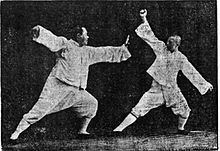Country of origin China Arts taught T'ai chi ch'uan Ancestor arts Chen-style taijiquan | Official website YangFamilyTaichi.com Current head Yang Zhenduo Date founded 1st half of 19th century | |
 | ||
Also known as Yang-style taijiquan
Yang family t'ai chi ch'uan
Yang school of t'ai chi ch'uan
Yang shi taijiquan Practitioners Yeo Hock Kiat
Yang Jianhou
Yang Chengfu
Zheng Manqing
Dong Yingjie
Zhang Qinlin
Yang Jun
Chu Guiting Founder Yang Luchan; (aka Yang Fukui) Descendant arts Guang Ping Yang taijiquan; Yangjia Michuan taijiquan; Wu (Hao)-style taijiquan; Wu-style taijiquan | ||
Yang family-style (Chinese: 楊氏; pinyin: Yángshì) t'ai chi ch'uan (taijiquan) in its many variations is the most popular and widely practised style in the world today and the second in terms of seniority among the primary five family styles of t'ai chi ch'uan.
Contents
History
The Yang family first became involved in the study of t'ai chi ch'uan (taijiquan) in the early 19th century. The founder of the Yang-style was Yang Lu-ch'an (楊露禪), aka Yang Fu-k'ui (楊福魁, 1799–1872), who studied under Ch'en Chang-hsing starting in 1820. Yang became a teacher in his own right, and his subsequent expression of t'ai chi ch'uan became known as the Yang-style, and directly led to the development of other three major styles of t'ai chi ch'uan (see below). Yang Lu-ch'an (and some would say the art of t'ai chi ch'uan, in general) came to prominence as a result of his being hired by the Chinese Imperial family to teach t'ai chi ch'uan to the elite Palace Battalion of the Imperial Guards in 1850, a position he held until his death.
Yang Lu-ch'an passed on his art to:
Yang Chengfu removed the vigorous fā jìn (發勁 release of power) from the Hand (solo) Form, as well as the energetic jumping, stamping, and other abrupt movements in order to emphasise the Da jia (大架 large frame style), but retained them in the Weapons (sword, saber, staff and spear) forms. The Hand Form has slow, steady, expansive and soft movements suitable for general practitioners. Thus, Yang Chengfu is largely responsible for standardizing and popularizing the Yang-style t'ai chi ch'uan widely practised today.
Modern Short forms
The Cheng Man-ch'ing (Zheng Manqing) and Chinese Sports Commission short forms are said to be derived from Yang family forms, but neither is recognized as Yang family t'ai chi ch'uan by current standard-bearing Yang family teachers. The Chen, Yang and Wu families are now promoting their own shortened demonstration forms for competitive purposes.
Yang Chengfu also developed his own shortened version of the Yang Long Form in order to have it easier to teach to modern students who are busy with modern life. Despite being shortened, Yang Chengfu managed to keep the essentials of the Yang Long form. Correctly taught and practiced, the 108 movement form still retains much of its health and self-defense benefits (the original comprises over 300 movements).
The Chinese government has also commissioned short 16 Forms from each of the five major families recently. Although the 16 Forms have now been taught for some time, the families all presented them as a set to attendees of the First International Tai Chi Chuan Symposium in Nashville, TN in July 2009.
Yang Shou-chung
Yang Shou-chung (aka Yeung Sau Chung, Yang Zhen-Ming, 1910–1985) is from the fourth generation of the Yang family. He was the oldest son of Yang Chengfu by his first marriage, and started learning his family-style when he was eight years old under the strict supervision of his father.
In 1949, he escaped from the Chinese communists to Hong Kong. There he taught many students privately at his home until his death in 1985.
He had three daughters—Tai Yee, Ma Lee, and Yee Li—and all continue to teach in Hong Kong. Over the years he had taught many people, but he accepted only three people as his disciples. These Yang family t'ai chi ch'uan practitioners are:
Yang Zhen Duo
Grandmaster Yang Zhen Duo is from the fourth generation of the Yang family and is officially the Fourth Lineage Holder of the Traditional Yang-style T'ai chi ch'uan. He was born in Beijing in 1926 and is the third son of Yang Chengfu. He started studying with his father when very young and continued studying with his older brothers and Zhao Bin after his father died. In 1960, Yang Zhen Duo moved to Taiyuan, Shanxi Province. Since then, Yang-style t'ai chi ch'uan has gradually spread within Taiyuan and to other cities, provinces, and countries.
Since 1980, he has served as Vice-President of the Shanxi Wushu Association. In 1982 Yang Zhen Duo founded the Shanxi Yang Style Tai Chi Chuan Association, and has served as President since. The Association has now grown to over 30,000 members throughout the Province and is the largest martial arts organization of its kind in China. In October 1998, Yang Zhen Duo founded the International Yang Style Tai Chi Chuan Association, serving as Chairman of the Board. Under his leadership, the International Association has grown to 28 centers in 12 countries with over 2,000 members. The Chinese Wushu Academy recognized Master Yang Zhen Duo in 1996 as one of the top 100 Wushu Masters in China. He has also been honored by proclamations from the Mayors of San Antonio, Texas and Troy, Michigan.
In July 2009, at the First International Tai Chi Chuan Symposium, held at Vanderbilt University, in Nashville, TN, Grandmaster Yang Zhen Duo officially named his grandson Yang Jun as the Fifth Lineage Holder of the Traditional Yang-style T'ai chi ch'uan.
